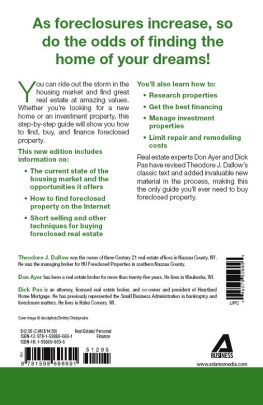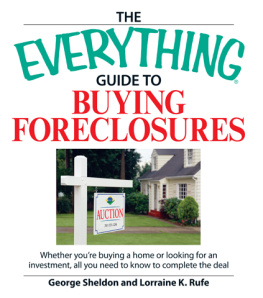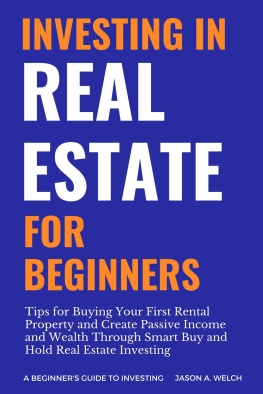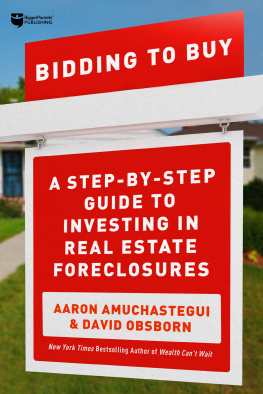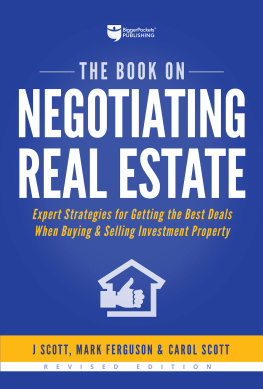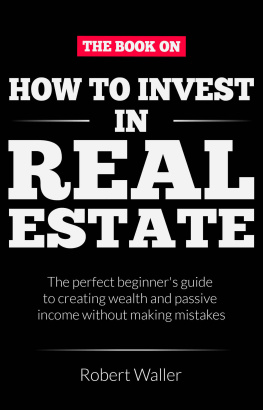
THIRD EDITION
HOW TO BUY
Foreclosed
Real Estate
For a Fraction of Its Value
THIRD EDITION
HOW TO BUY
Foreclosed
Real Estate
For a Fraction of Its Value
Theodore J. Dallow with Don Ayer and Dick Pas

Copyright 2008 by Theodore J. Dallow
All rights reserved.
This book, or parts thereof, may not be reproduced in any
form without permission from the publisher; exceptions are
made for brief excerpts used in published reviews.
Published by Adams Business, an imprint of
Adams Media, an F+W Publications Company
57 Littlefield Street, Avon, MA 02322. U.S.A.
www.adamsmedia.com
ISBN 10: 1-59869-669-6
ISBN 13: 978-1-59869-669-1
eISBN: 978-1-44051-552-1
Printed in Canada.
J I H G F E D C B A
Library of Congress Cataloging-in-Publication Data
is available from the publisher.
This publication is designed to provide accurate and authoritative information with regard to the subject matter covered. It is sold with the understanding that the publisher is not engaged in rendering legal, accounting, or other professional advice. If legal advice or other expert assistance is required, the services of a competent professional person should be sought.
From a Declaration of Principles jointly adopted by a Committee of the
American Bar Association and a Committee of Publishers and Associations
Many of the designations used by manufacturers and sellers to distinguish their product are claimed as trademarks. Where those designations appear in this book and Adams Media was aware of a trademark claim, the designations have been printed with initial capital letters.
This book is available at quantity discounts for bulk purchases.
For information, please call 1-800-289-0963.
Contents
PART ONE
How Did We Get Here?
CHAPTER 1
If 75 Million People Lose, Say, $35,000 Each, Is That a Good Day at the Office?
CHAPTER 2
Moving on to Mortgage Lending
CHAPTER 3
Important Recent History
CHAPTER 4
The Rise and Fall of Subprime Lending
CHAPTER 5
How Foreclosures Happen
CHAPTER 6
Payment Option Loans and Other Loan Types
CHAPTER 7
The Best Mortgage Loan and the Second-Best Mortgage Loan
CHAPTER 8
Other Reasons for Foreclosure
CHAPTER 9
Deed in Lieu of Foreclosure
PART TWO
How to Buy Foreclosed and Distressed Properties
CHAPTER 10
You Have to Know the Numbers
CHAPTER 11
PreforeclosureContacting Mortgagors Prior to the Sale
CHAPTER 12
Acquire Knowledge and Avoid Emotional Pitfalls
CHAPTER 13
Short Sales
CHAPTER 14
Before the Sale
CHAPTER 15
Preparing for the Sale
CHAPTER 16
The Sale
CHAPTER 17
After the Sale
CHAPTER 18
Calculating a Bid Price for Investment Property
CHAPTER 19
Investment Real Estate
CHAPTER 20
Managing Investment Real Estate
CHAPTER 21
Those Easy-Money, No-Cash Commercials and Seminars
PART THREE
The Road Ahead
CHAPTER 22
Fear and Greed
CHAPTER 23
Fine-Tuning Your Thinking
CHAPTER 24
We Didnt Know Mortgages and Real Estate Were That Important
APPENDIX A
Frequently Asked Questions
APPENDIX B
Checklists
APPENDIX C
Standard Buyers Agreement
APPENDIX D
Glossary of Crucial Terms
Acknowledgments
The authors gratefully acknowledge
the skill and enthusiasm of B. K. Nelson.
Foreword
REAL ESTATE SOARED and real estate plunged. The summer of 2007 saw the nations highest rate of foreclosures in the forty-four years recorded by the national Mortgage Bankers Association. According to the association, 5.06 percent of mortgage customers in the United States are delinquent and 1.4 percent are in foreclosure.
As one newspaper headline read, Were not out of the woods yet. Headlines similar to this are appearing all over the nation. They were a long time coming. The recent historic real estate boom originated in a very long period of low interest rates (by recent standards). The Federal Reserve began an historic drop of short-term interest rates in mid-May 2000. They continued to reduce these rates (sharply after the September 11, 2001, terrorist attacks) until interest rates reached their low point in late June 2003. On July 1, 2004, the Federal Reserve began the first of seventeen quarter-percent interest rate increases, continuing through late June 2006. Rates held at that level until the September 18, 2007, half a percentage point reduction. The Great Real Estate Boom was a lagging but highly powerful response to low interest rates. The Great Boom began at various dates in various markets but was raging in most real estate markets by 2003. The Great Fall likewise became apparent at different dates in different markets but was widespread by mid-2005, later in some markets. The boom was fueled by widespread availability of subprime and nonconventional loans and a general consensus that real estate values would continue to soar. Home ownership in the United States reached a historic high in 2004 when 69 percent of the population owned their own homes.
The end of the real estate boom actually had its origins with that first of seventeen consecutive actions over the next two years by the Federal Reserve Open Market Committee. Those rising interest rates finally induced first a slowing housing market, then the Great Fall, aided and again accompanied by a mass psychological swing, this time against real estate acquisition and investment.
The lightning-fast collapse in early 2007 of much subprime lending was reinforced by a negative real estate market in most of the country. Some local real estate markets have held up quite well, with relative price stability and even price increases. Places in the Northwest like Portland and Seattle, some of the Carolinas, and the oil-boom town of Casper, Wyoming, come to mind. In other places, such as San Diego and much of the rest of California; Las Vegas, Nevada; much of Florida; Arizona; and large portions of Michigan, Ohio, and Indiana, real estate values have dramatically gone the other way.
With academics, trade-association economists, and government number-crunchers tossing off figures left and right, no one can be absolutely certain how many single-family properties in the United States will see foreclosure. Most experts do agree that the rate of financially distressed properties or foreclosures is unlikely to decline any time soon.
The ripples of the real estate crisis continue to spread. On September 11, 2007, the Wall Street Journal reported that Bear Stearns, a large Wall Street firm much in the headlines because of its large subprime lending involvement, had seen its share price drop 34 percent since the start of the year. Over the next two weeks, the Federal Reserve cut both discount and Fed funds rates by half a percent, and by September 23, Bear Stearnss share price had edged back to roughly a 28 percent drop undoubtedly aided by the September 18, 2007, half a percentage point interest rate cut.
These events have struck especially hard at the mortgage industry. In August 2007, several large mortgage firms that together had been responsible for the annual purchase of $118 billion in mortgage loans ceased operations. During a single week of that same month, six mortgage or financial firms cut 13,000 jobs, virtually all of them mortgage related.
Next page
